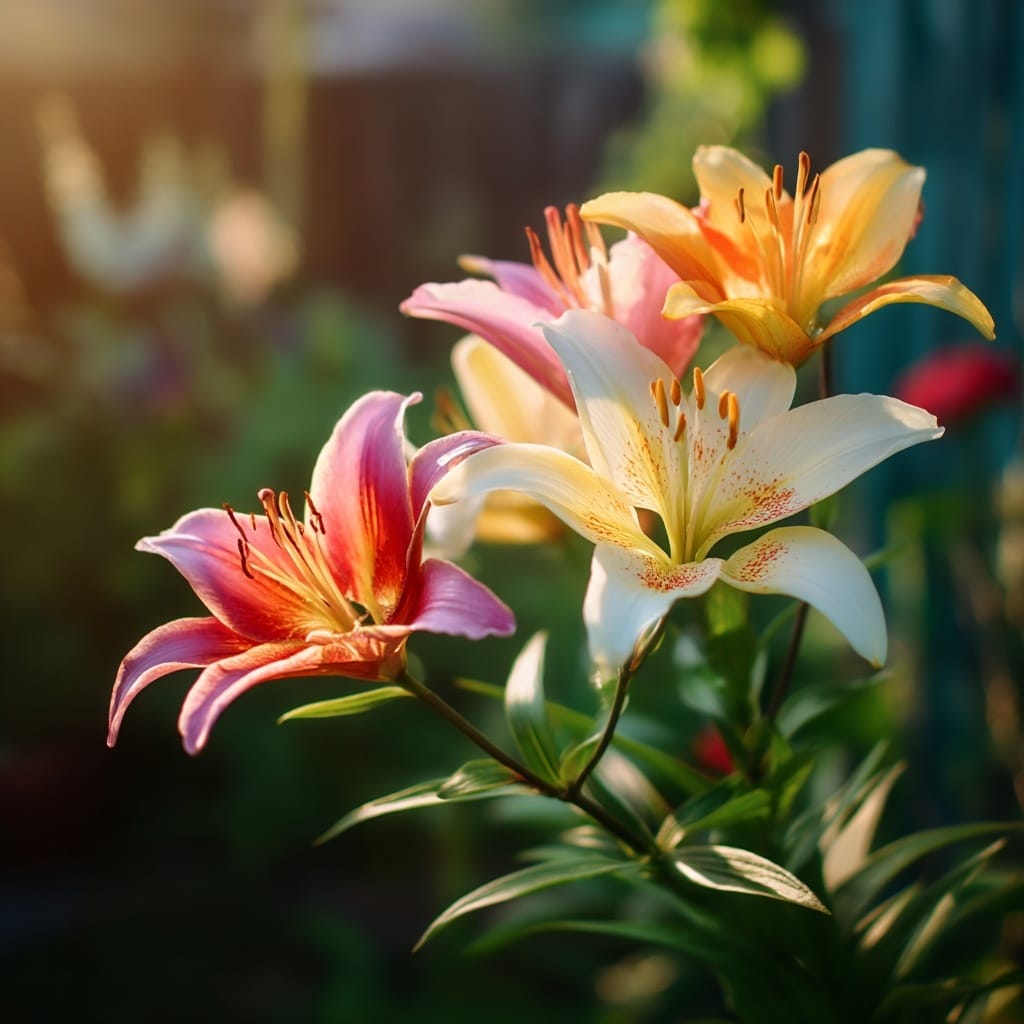Lily flower blooms bring elegance, fragrance, and vibrant color to any garden, making them one of the most beloved flowers among home gardeners. From tall, fragrant Oriental lilies to bold, easy-care Asiatic types, the lily flower is a versatile perennial that fits beautifully into borders, containers, or even cutting gardens. With the right planting techniques and care, lily flowers can return year after year with larger, more spectacular blooms.
Table of Contents
What Is a Lily Flower?
The lily flower belongs to the genus Lilium and is considered a “true lily,” unlike daylilies or peace lilies, which share the name but not the botanical family. True lilies grow from scaly bulbs, not tubers or roots, and produce tall, upright stems topped with large, showy blooms.
A typical lily flower has six petals (technically called tepals), often marked with freckles or bold color gradients. The flowers may be trumpet-shaped, bowl-shaped, or recurved depending on the variety, and they appear in a rainbow of colors—from pure white and blush pink to deep red, golden yellow, or vibrant orange.
Most lily flowers also feature lance-shaped leaves that grow in whorls or spirals along the stem. Depending on the type, lilies can range in height from 2 to over 6 feet tall, making them dramatic focal points in garden beds or containers.
Beyond their looks, many lily varieties are also known for their intense fragrance, especially Oriental and Trumpet hybrids. Their long-lasting blooms make them a favorite for cut flower arrangements, and they’re loved by pollinators like butterflies and bees.
Types of Lily Flowers
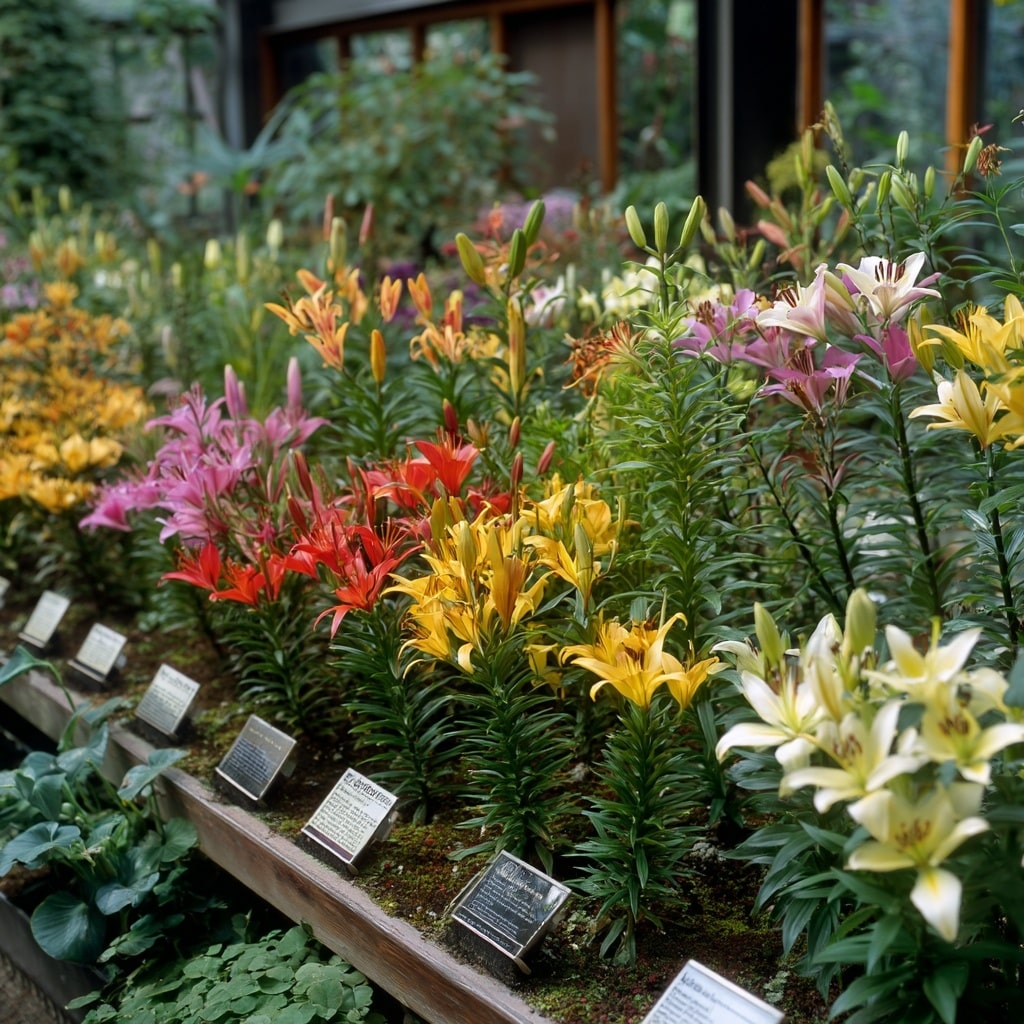
With over 8,000 registered hybrids, the lily flower family offers an incredible range of color, height, fragrance, and bloom times. Here are the most widely grown types, each with its own unique charm.
Asiatic Lilies
- Bloom Time: Early to mid-summer
- Height: 2 to 4 feet
- Fragrance: Minimal to none
Asiatic lilies are among the earliest bloomers and the easiest to grow, making them perfect for beginners. They come in bold, bright colors like orange, red, yellow, and white. While they lack fragrance, their upright flowers and compact growth make them ideal for containers, borders, and cutting gardens.
Popular varieties:
- ‘Gran Paradiso’ – Deep red blooms, 3–4 ft tall
- ‘Patricia’s Pride’ – White flowers with dramatic purple brush strokes
Oriental Lilies
- Bloom Time: Mid to late summer
- Height: 3 to 6 feet
- Fragrance: Strong and spicy
Known for their massive blooms and intense perfume, Oriental lilies are garden showstoppers. They grow taller and more slowly than Asiatics but reward you with elegant pink, white, or red flowers. They’re perfect for creating impact in mixed borders or as focal points in a flower bed.
Popular varieties:
- ‘Stargazer’ – Iconic deep pink flowers with white edges
- ‘Casa Blanca’ – Pure white blooms with intoxicating fragrance
- ‘Black Beauty’ – Dark red, funnel-shaped blooms
Trumpet Lilies
- Bloom Time: Mid-summer
- Height: 4 to 6 feet
- Fragrance: Sweet and heady
These lilies produce trumpet-shaped blooms in large clusters—up to 15 flowers per stalk. Their strong stems and stunning scent make them great for cutting and floral displays. Trumpets prefer full sun and well-drained soil.
Popular varieties:
- ‘Album’ – Regal white trumpet-shaped flowers
- ‘Yellow Planet’ – Large buttery yellow blooms
Easter Lilies (Lilium longiflorum)
- Bloom Time: Spring (indoors), late summer (outdoors after transplanting)
- Height: 2 to 3 feet
- Fragrance: Moderate
Often sold as holiday plants, Easter lilies can be planted outdoors after blooming and will often return the following year in warmer zones (4–9). With care, they can become long-term garden fixtures.
Native and Wild Lilies
- Turk’s Cap Lily (L. superbum): Recurved orange petals with dark spots; grows up to 7 feet
- Canada Lily (L. canadense): Graceful yellow to red blooms; thrives in woodland settings
- Wood Lily (L. philadelphicum): Smaller, upright orange flowers; great for naturalized gardens
These species are perfect for gardeners looking to support pollinators or create a more naturalistic landscape.
Tip: To enjoy continuous blooms, plant a mix of Asiatic, Trumpet, and Oriental lilies. You’ll get flowers from early summer well into August or September.
When and Where to Plant Lily Flowers
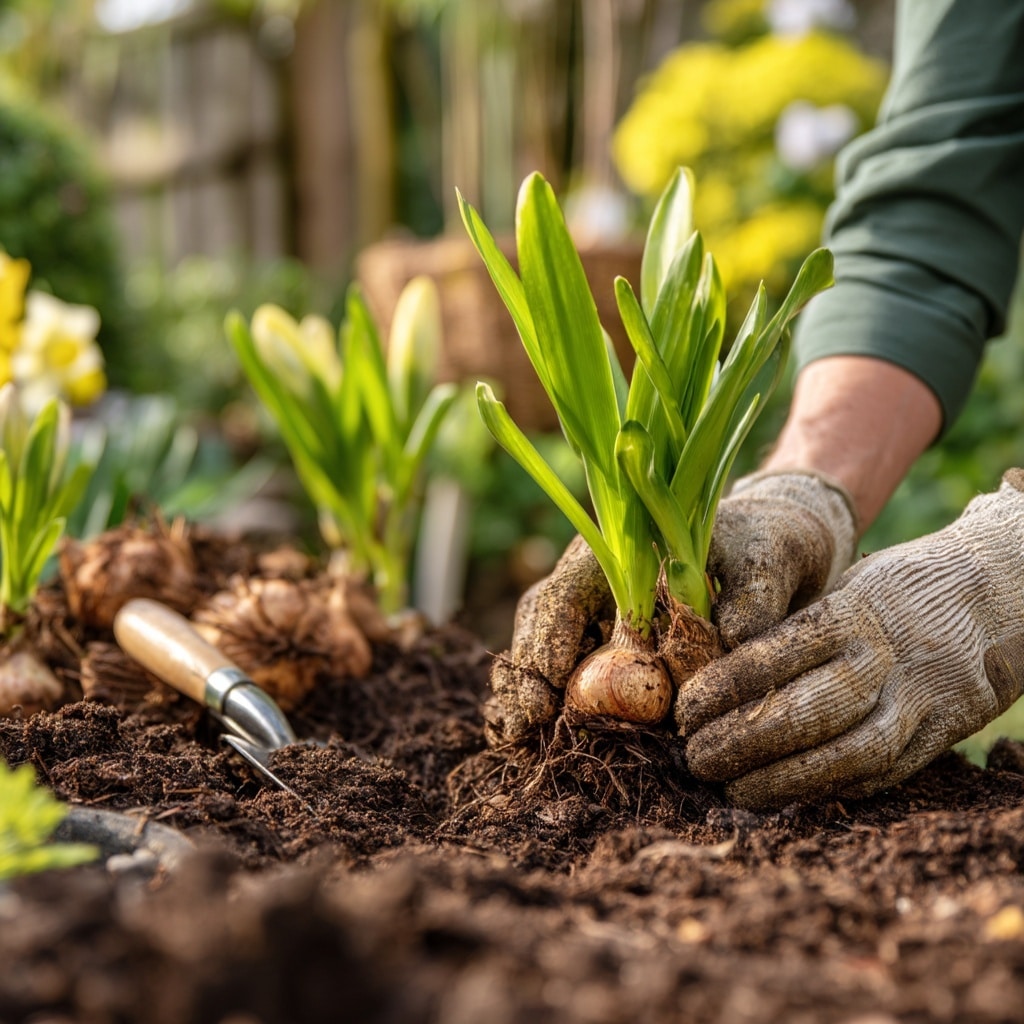
Proper timing and location are key to growing strong, vibrant lily flowers. While lilies are hardy and adaptable, choosing the right planting window and site conditions makes all the difference in their growth and blooming potential.
Best Time to Plant Lily Bulbs
Fall and spring are the best seasons for planting lily bulbs, depending on your region:
- Fall Planting:
Ideal in most zones (especially Zones 4–7).
Plant 4–6 weeks before the first frost to allow bulbs to root before winter. - Spring Planting:
Best for areas with harsh winters where fall planting isn’t feasible.
Plant as soon as the soil is workable and danger of frost has passed.
Lily bulbs don’t go fully dormant—buy and plant them as fresh as possible. Avoid storing for long periods.
Ideal Sunlight Conditions
Lilies need full sun to thrive. Ensure your site gets:
- At least 6 to 8 hours of direct sunlight per day
- Good air circulation to prevent disease and mold
Too much shade can lead to weak stems and poor blooming. Lilies will lean toward the sun if planted in partial shade, which can cause them to topple.
Soil Requirements
The right soil encourages strong root development and prevents rot:
- Well-draining soil is essential – lily bulbs will rot in soggy conditions
- Loosen soil to 12–15 inches deep to promote drainage
- Enrich with compost, aged manure, or leaf mold before planting
- Most lilies prefer neutral to slightly acidic soil, though some (like Madonna lilies) tolerate alkaline conditions
Tip: Test your soil after heavy rain. If it dries quickly, it’s likely suitable for lilies.
How to Plant Lily Bulbs
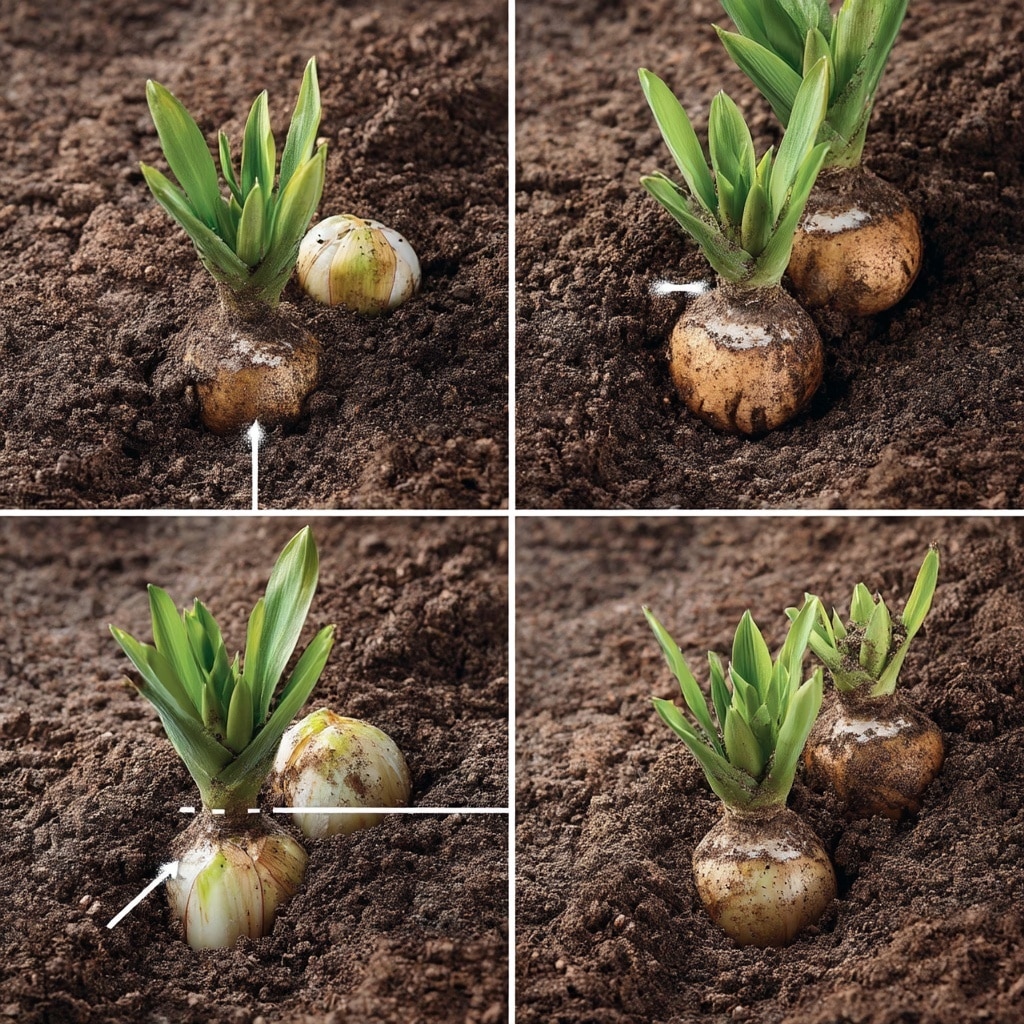
Planting a lily flower the right way sets the stage for healthy growth and stunning blooms. Whether you’re creating a full garden bed or planting a few bulbs in containers, following these steps ensures your lilies thrive.
Step-by-Step: Planting Lily Bulbs in the Ground
- Loosen the Soil
Dig the planting area to a depth of 12 to 15 inches. This allows proper drainage and room for root development. - Add Organic Matter
Mix in compost or aged manure to enrich the soil. If your soil is heavy clay, consider adding coarse sand or grit for improved drainage. - Dig the Planting Hole
Plant bulbs 3 times as deep as the bulb is tall—usually about 6 to 8 inches deep for full-sized lilies. - Set the Bulb Properly
Place each bulb pointy side up (the growing tip) and the flat root plate down. This is crucial for proper sprouting. - Space the Bulbs
Leave 8 to 18 inches between bulbs depending on the variety. Crowded bulbs can lead to poor air circulation and disease. - Backfill and Firm Gently
Cover the bulb with soil, tamp it down lightly, and water thoroughly to settle the soil. - Mulch Lightly
Add a thin layer of mulch to retain moisture and protect from temperature swings. Avoid heavy mulching at this stage.
Pro Planting Tips
- Plant in Groups of 3–5 bulbs for a more natural and full look in the garden.
- Use buried wire cages if pests like voles or squirrels are a concern.
- If planting in heavy rainfall areas, raise the bed slightly to prevent standing water.
🌧️ Lilies hate wet feet! Good drainage is just as important as sunlight.
Caring for Lily Flowers

Once planted, the lily flower doesn’t demand much—just consistent care through the growing season and a little attention before winter. With proper watering, feeding, and maintenance, you’ll enjoy strong stems and vivid blooms season after season.
Watering
- During growth and bloom: Water deeply once a week, or more during dry spells. Ensure the top few inches of soil stay moist, but never soggy.
- After flowering: Reduce watering but don’t allow the soil to dry out completely.
- In containers: Check moisture more frequently—potted lilies dry out faster than garden soil.
Tip: Use soaker hoses or gentle watering at the base to avoid wetting the foliage, which can invite fungal issues.
Mulching
Apply 2 to 4 inches of mulch around the base to help retain moisture, regulate soil temperature, and keep weeds down. Organic mulches like shredded bark or leaf mold work best.
Fertilizing
Feed your lily flowers regularly to support strong stems and vibrant blooms:
- Use a balanced or high-potassium fertilizer (e.g., 10-10-10 or 5-10-10)
- Begin feeding in early spring when shoots appear
- Continue every 2–3 weeks until 6 weeks after flowering ends
- Apply a thin layer of compost in early spring as a natural nutrient boost
Pruning and Deadheading
- Remove spent flowers by snipping just below the bloom. This stops seed production and redirects energy to the bulb.
- Leave stems and leaves intact until they yellow and die back naturally in fall—this allows photosynthesis to recharge the bulb for next year.
- Cut down dead stalks in late fall or early spring.
Never cut green foliage! The bulb needs it to store energy.
Winter Care
- In zones with freezing winters, add 4 to 6 inches of mulch after the first hard frost to protect bulbs from ground freeze.
- In areas without snow cover, water sparingly during winter to prevent the soil from drying out completely.
- Remove mulch gradually in spring once shoots start to emerge.
Dividing Lilies
Divide your lily clumps every 3 to 4 years to prevent overcrowding:
- Best time: Early spring, just as new growth starts
- Lift the bulbs gently and separate offsets
- Replant the divisions with compost-enriched soil
Growing Lilies in Containers

The lily flower isn’t just for garden beds — it grows beautifully in pots, planters, and balcony containers. With the right setup, container-grown lilies can thrive, bloom generously, and even be moved around to follow the sun or decorate different areas.
Choosing the Right Container
- Use a sturdy container that’s at least 12 inches deep and has good drainage holes.
- Choose wide pots to accommodate multiple bulbs without crowding.
- Heavy ceramic or terra cotta pots are great for stability, especially for tall varieties like Oriental or Trumpet lilies.
Soil and Planting Tips
- Use well-draining potting mix with added compost or slow-release fertilizer.
- Avoid moisture-retentive mixes with peat moss unless mixed with sand or grit for better drainage.
- Plant bulbs 4 to 6 inches deep, with 3 to 5 bulbs per pot spaced evenly.
- Keep the growing tips just below the soil surface.
Sunlight and Watering
- Place the container in full sun—at least 6 to 8 hours of direct sunlight per day.
- Water thoroughly when the top 1–2 inches of soil feel dry.
- Avoid letting containers dry out completely, especially in warm weather.
Maintenance
- Stake tall varieties to keep stems upright.
- Rotate the pot occasionally to promote even growth and flowering.
- Apply a balanced liquid fertilizer every 2–3 weeks during the growing season.
🌡️ In cold regions, containers may need to be moved indoors or into a garage over winter to prevent bulb freeze.
Pests, Diseases, and Wildlife Issues

While lily flowers are hardy and resilient, they can occasionally fall victim to destructive insects, fungal diseases, or curious animals. Here’s how to recognize common problems — and what to do about them.
Common Lily Pests
- Red Lily Beetle (Lilioceris lilii):
Bright red adults and larvae chew through leaves, buds, and stems.
👉 Control: Hand-pick beetles, crush larvae, or apply neem oil or insecticidal soap early in the season. - Aphids:
Tiny green or black insects that cluster on new growth and buds, spreading viruses.
👉 Control: Spray with water or use horticultural soap or neem oil. - Slugs and Snails:
Leave ragged holes in foliage, especially on young shoots.
👉 Control: Use iron phosphate pellets or copper tape around containers and beds.
Fungal Diseases
- Gray Mold (Botrytis):
Causes spotted or mushy petals, often in wet or overcrowded conditions.
👉 Control: Improve air circulation, remove infected tissue, and avoid overhead watering. - Basal Rot:
Affects bulbs planted in poorly draining soil.
👉 Control: Always use well-draining soil; discard and destroy any soft, rotting bulbs.
Wildlife Damage
- Deer, Rabbits, and Voles:
May eat entire plants or dig up bulbs.
👉 Control: Use wire cages for bulbs or apply safe repellents. Consider raised beds or fencing. - Groundhogs and Squirrels:
Can disturb soil and uproot bulbs.
👉Control: Use physical barriers or plant lilies in buried mesh baskets.
Reminder: All parts of the lily flower are highly toxic to cats — even the pollen. Avoid bringing cut lilies indoors if you have feline friends.
Harvesting Lily Flowers for Vases
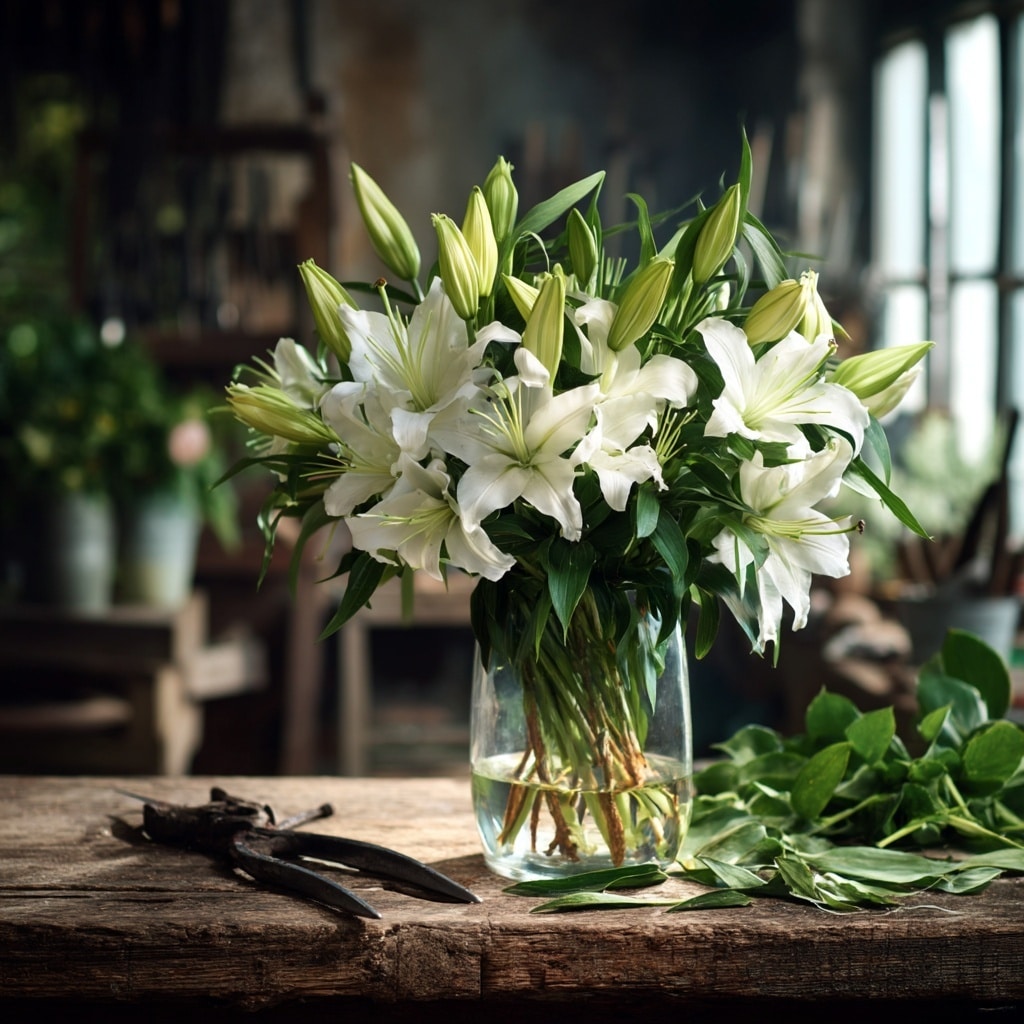
The lily flower makes an exceptional cut flower — tall, striking, and long-lasting in a vase. When cut properly, lilies can decorate your home for over a week without reducing the plant’s long-term vitality.
When to Cut
- Choose blooms just starting to open, with color visible on the outer petals.
- Avoid cutting stems with fully opened flowers — they won’t last as long indoors.
- Always cut in early morning or late evening, when plants are hydrated.
How to Cut Without Harming the Plant
- Use clean, sharp pruners or a knife.
- Never remove more than one-third of the total stem — the plant needs remaining foliage for photosynthesis and next year’s bloom cycle.
- For cutting gardens, plant extras you can harvest freely without worrying about future performance.
Vase Conditioning Tips
- Cut stems on a diagonal to increase water uptake.
- Remove lower leaves that would sit below the waterline — this prevents rot and bacterial growth.
- Place stems in lukewarm water immediately after cutting.
Pollen & Pet Precautions
- To avoid staining fabrics, carefully snip off the anthers (the pollen-covered parts) after the flowers open.
- ⚠️ Toxic to cats: Avoid bringing lily flowers indoors if you have cats. Even brushing against pollen can be life-threatening.
How Long Will They Last?
With proper care, cut lily flowers can last 10–14 days in a vase. For best results:
- Change water every 2–3 days
- Re-trim stems slightly every few days
- Add flower preservative (use only half strength for lilies)
FAQs About Lily Flowers
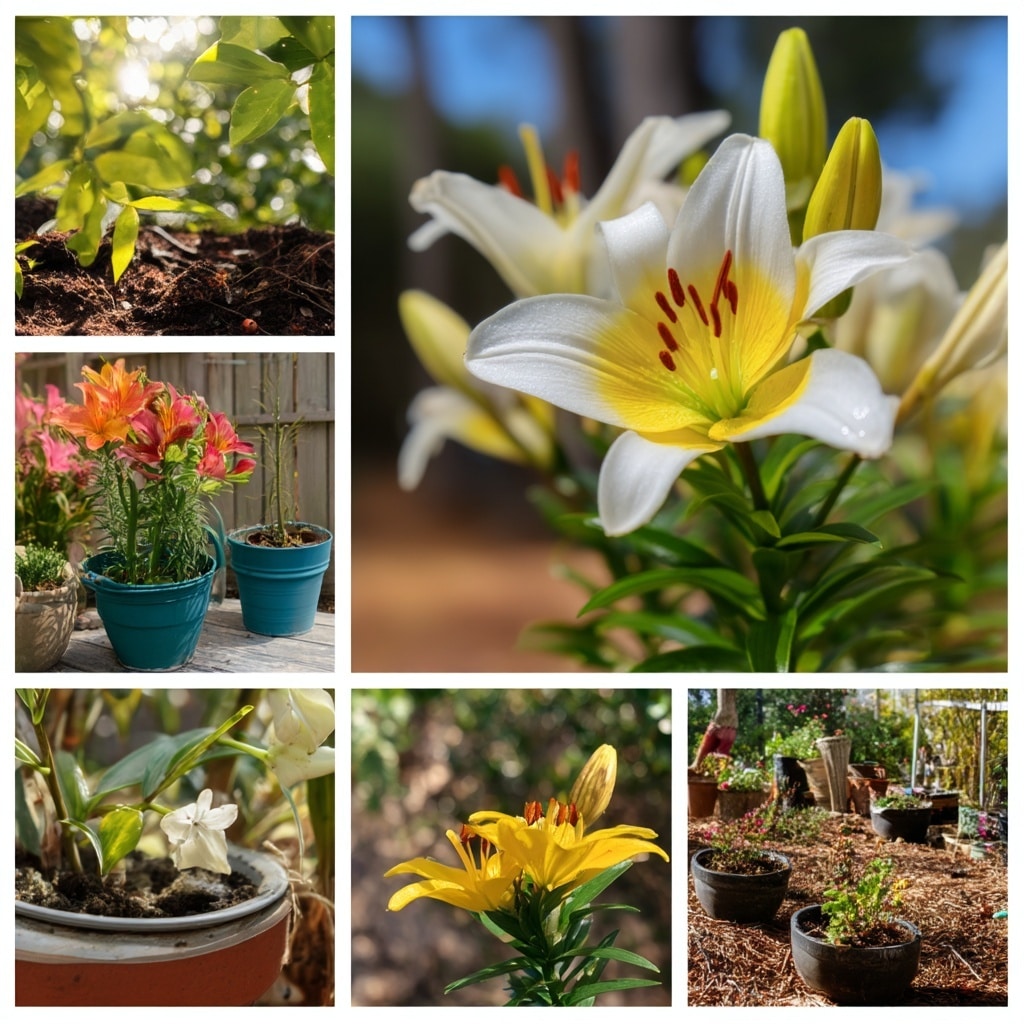
How long do lily flowers bloom?
Most lily flowers bloom for 1 to 2 weeks, depending on the variety and growing conditions. By planting a mix of early (Asiatic), mid-season (Trumpet), and late-season (Oriental) lilies, you can enjoy continuous blooms from late spring through summer.
Can I grow lilies in containers?
Yes — lily flowers grow very well in containers as long as the pot is deep enough (at least 12 inches), has good drainage, and receives full sun. Choose compact or dwarf varieties for smaller pots.
Why aren’t my lilies blooming?
If your lily flowers aren’t blooming, it could be due to:
- Too little sunlight
- Poor drainage or overwatering
- Bulbs planted too shallow
- Lack of nutrients
- Plants are overcrowded and need dividing
Are lilies toxic to pets?
Yes — all parts of the lily flower are extremely toxic to cats. Even a small amount of pollen or a lick of water from a lily vase can cause fatal kidney failure. Avoid keeping lilies indoors if you have cats.
Can lilies survive winter?
Yes — most lilies are hardy perennials and will survive winter in Zones 4–9. In colder regions, mulch heavily in late fall to protect bulbs from freezing. Container-grown lilies should be moved to a protected area if your winters are harsh.
Conclusion
The lily flower brings timeless elegance, vibrant color, and even fragrance to gardens of all sizes. With proper planting, seasonal care, and a little protection from pests and frost, lilies will reward you with spectacular blooms year after year. Whether you grow them in beds, containers, or as cut flowers for your home, lilies are one of the most satisfying and low-maintenance perennials a gardener can grow.
Choose your favorite varieties, plant at the right depth, and give them the sun they crave — and your lilies will flourish for seasons to come.



